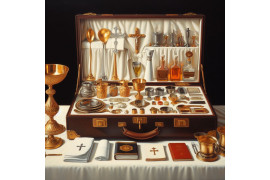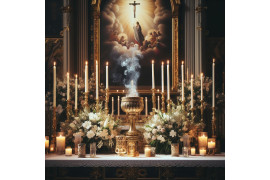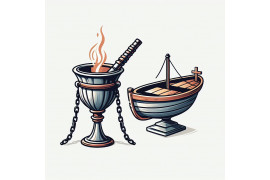Church lighting plays a crucial role in enhancing the overall ambiance and atmosphere of the worship space. With its large impact, it improves visibility for both congregants and performers, ensuring that everyone can fully engage with the service. Church lighting sets the mood for different parts of the service, such as sermons or musical performances, creating a dynamic and immersive experience for attendees. By carefully selecting and designing lighting elements, churches can create a welcoming and inclusive environment that fosters a sense of community among worshipers. So, let's dive in!
Types of Lighting Technology for Churches
LED lighting, moving lights, intelligent lighting systems, and traditional incandescent lighting are some of the types of lighting technology commonly used in churches. Each type offers unique features and benefits that contribute to creating a captivating and spiritually uplifting atmosphere during worship services. Let's explore these lighting technologies in more detail.
LED Lighting: Energy Efficiency and Long Lifespan
LED technology has revolutionized the world of lighting, including churches. LED lights are highly energy-efficient, consuming less electricity compared to traditional incandescent bulbs. This not only helps churches reduce their energy costs, but also aligns with their commitment to environmental sustainability.
LED lights have an impressively long lifespan, lasting up to 50,000 hours or more. This means fewer replacements and maintenance efforts for church staff, allowing them to focus on other important tasks. LED lights also produce bright and consistent illumination without flickering or warm-up time, ensuring a seamless worship experience for congregants.
Moving Lights: Versatility in Creating Dynamic Effects
Moving lights add excitement and versatility to church lighting setups. These fixtures can be controlled remotely and offer various movement options like pan (side-to-side) and tilt (up-and-down), enabling the creation of dynamic lighting effects that enhance the worship experience.
With moving lights, churches can easily change the direction, color, intensity, and pattern of light beams during different parts of the service. This flexibility allows for creative expression during performances or special events within the church community.
Intelligent Lighting Systems: Easy Control and Customization
Intelligent lighting systems provide advanced control capabilities for churches. These systems allow users to adjust settings such as brightness levels, color temperature, beam angles, and even create pre-programmed scenes that suit specific occasions or moods.
Church technicians can operate these systems through user-friendly interfaces like touchscreens or software applications on computers or mobile devices. With just a few taps or clicks, they can effortlessly modify the lighting to match the ambiance required for different parts of the service, such as worship, preaching, or prayer.
Traditional Incandescent Lighting: Specific Purposes and Aesthetic Preferences
While modern lighting technologies like LED, moving lights, and intelligent systems dominate the church lighting scene, traditional incandescent lighting still has its place. Some churches may prefer the warm and nostalgic glow that incandescent bulbs provide for specific purposes or to maintain a traditional aesthetic.
Incandescent lights can be used to create a cozy and intimate atmosphere during quieter moments of worship, or for accentuating certain architectural features of the church. However, it's important to note that incandescent bulbs are less energy-efficient compared to LEDs and have shorter lifespans.
Factors to Consider for Optimal Church Lighting
To ensure a vibrant and engaging atmosphere within a church, several factors need to be considered when choosing the right lighting options. The size and layout of the worship space, color temperature choice, proper fixture positioning, and dimming capabilities all play crucial roles in creating quality lighting that enhances the overall worship experience.
Size and Layout of the Worship Space
The size and layout of a church greatly influence its lighting requirements. A larger space may necessitate more powerful fixtures to provide adequate illumination throughout. Conversely, smaller churches can benefit from more focused beams that highlight specific areas or architectural features. Understanding the dimensions of the worship space is essential for selecting lighting options that effectively cover every corner without creating excessive glare or shadows.
Color Temperature Choice
Color temperature refers to the warmth or coolness of light emitted by fixtures. It has a significant impact on the mood and perception within a church. Warmer color temperatures (around 2700-3000K) create a cozy and intimate ambiance suitable for traditional services or evening events. On the other hand, cooler color temperatures (around 4000-5000K) lend themselves well to contemporary services or spaces where clarity and focus are important. Finding the right balance between warm and cool tones can help create an inviting environment that aligns with the church's aesthetic.
Proper Positioning of Fixtures
Properly positioning fixtures is crucial for achieving even illumination without glare or shadows. Ceiling-mounted fixtures should be strategically placed to distribute light evenly across pews, altars, podiums, and other focal points within the church. Wall sconces can add depth and dimension while highlighting architectural details. Using adjustable fixtures allows for flexibility in directing light precisely where it is needed most.
Dimming Capabilities
Having dimming capabilities in church lighting allows for adjustment according to different activities or events taking place within the space. Brighter lighting may be required during sermons or performances, while softer lighting can create a more intimate atmosphere during prayer or meditation. The ability to control the intensity of light adds versatility and adaptability to the worship environment.
Considering these factors when selecting lighting options for a church ensures that the congregation can fully immerse themselves in the worship experience. By tailoring the lighting to suit the size and layout of the space, choosing an appropriate color temperature, positioning fixtures effectively, and incorporating dimming capabilities, churches can create an atmosphere that enhances spiritual engagement and fosters a sense of community.
Enhancing Worship Experience with Stage Lighting
To create an immersive and captivating worship environment, churches often utilize various types of lighting setups. These lighting techniques can greatly enhance the overall worship experience and help convey the intended message effectively. Let's explore some key ways in which stage lighting is used in churches.
Spotlights: Highlighting Key Elements on Stage
Spotlights are a vital component of church stage lighting, as they allow for focused illumination on specific areas or individuals. By using spotlights, churches can highlight speakers, musicians, or important elements on stage, ensuring that they become the center of attention. This helps draw the congregation's focus and adds a sense of importance and reverence to those leading the worship services.
Color-Changing Lights: Evoking Emotions through Lighting
To further enhance the worship experience, many churches incorporate color-changing lights into their lighting setups. These lights can evoke different emotions during worship songs or readings by creating a visually dynamic atmosphere. For example, warm colors like red and orange can be used to convey passion and intensity, while cool colors like blue and purple can create a sense of calmness and tranquility. By strategically using color-changing lights, churches can amplify the emotional impact of their worship services.
Moving Lights: Creating Captivating Visual Effects
Another popular technique in church stage lighting is the use of moving lights. These lights are equipped with motors that allow them to move around and change positions during performances. By utilizing moving lights, churches can create captivating visual effects that enhance storytelling and engage the congregation on a deeper level. The dynamic movement of these lights adds an element of excitement and drama to the worship environment.
Gobos: Adding Texture and Depth to the Stage
Gobos are patterned light projections that can be used to add texture and depth to the stage. They are often placed in front of spotlights or other types of fixtures to create unique and visually appealing effects. Gobos can project patterns, shapes, or even religious symbols onto the stage, further enhancing the worship experience. By incorporating gobos into their lighting design, churches can add a touch of artistry and symbolism to their worship services.
Creating a Sacred Atmosphere with Contemporary Lighting
Pendant Lights: Setting the Mood with Warm Tones
To create an intimate and sacred atmosphere in churches, pendant lights with warm tones are often installed. These hanging fixtures provide illumination and add a touch of elegance to the space. The warm tones emitted by these lights help to create a cozy and inviting ambiance, perfect for fostering a sense of community and devotion among the congregation.
Pros:
-
Pendant lights with warm tones create an intimate setting.
-
They add elegance and sophistication to the interior of the church.
-
The cozy ambiance encourages a sense of community among worshipers.
Indirect Lighting: Illuminating Architectural Features Softly
Indirect lighting techniques play a crucial role in softly illuminating the architectural features of churches. By strategically placing light fixtures such as wall sconces or recessed lights, the focus is shifted from the source of light to the illuminated area itself. This technique enhances the beauty of intricate details, such as stained-glass windows or ornate ceilings, without overpowering them.
Pros:
-
Indirect lighting softly illuminates architectural features.
-
It highlights intricate details without overpowering them.
-
This technique adds depth and dimension to the space.
Candle-like LED Bulbs: A Traditional Touch in Chandeliers
Chandeliers are often used in churches to add grandeur and traditional aesthetics. To maintain this classic appeal while incorporating modern lighting technology, candle-like LED bulbs can be used. These bulbs mimic the soft glow of real candles while offering energy efficiency and safety advantages. By combining traditional design elements with contemporary lighting solutions, churches can strike a balance between tradition and innovation.
Pros:
-
Candle-like LED bulbs offer a traditional aesthetic.
-
They provide energy efficiency and safety benefits.
-
These bulbs maintain the charm of candlelit chandeliers without fire hazards.
Wall Sconces with Diffusers: Gentle Light on Religious Artwork
Religious artwork holds great significance in churches, and it is essential to showcase them in the best possible light. Wall sconces with diffusers are an excellent choice for this purpose. The diffusers help to soften the light and distribute it evenly, ensuring that the religious artwork is properly illuminated without any harsh glare or shadows.
Pros:
-
Wall sconces with diffusers cast gentle light on religious artwork.
-
They prevent harsh glare and shadows.
-
These fixtures enhance the visual impact of the artwork.
Incorporating Natural Light in Church Design
In many churches, the type of lighting used plays a crucial role in creating a sacred and inviting atmosphere. One effective way to achieve this is by incorporating natural light into the design of the church building. Let's explore some ways in which natural light can be utilized in churches.
Large Windows
One of the primary methods for bringing natural light into a church is through large windows. These expansive openings allow sunlight to flood the worship space during daytime services, creating a warm and uplifting ambiance. The abundance of natural light enhances visibility and adds a sense of connection to the outside world, allowing worshipers to feel closer to nature while inside the church.
Skylights
Skylights are another excellent option for introducing additional sunlight into churches. Placed strategically on the roof or high walls, skylights bring in natural light from above, illuminating the interior without compromising privacy. They can be particularly beneficial in larger churches with higher ceilings, as they help distribute light evenly throughout the space.
Clerestory Windows
Clerestory windows are an architectural feature commonly found in many churches. Positioned near the top of walls or above eye level, these windows allow ample natural light to enter while minimizing obstructions to views inside and outside the church building. By placing these windows strategically around the sanctuary or worship area, churches can achieve high-level illumination that creates an ethereal atmosphere during services.
Stained Glass Windows
Stained-glass windows have long been synonymous with church architecture and design. Not only do they add aesthetic beauty and visual interest to the interior of a church, but they also serve as sources of symbolic storytelling. Stained-glass windows filter incoming daylight into vibrant hues, casting colorful patterns across floors and walls. This interplay between light and color creates a captivating environment that helps set apart religious spaces.
Future Trends in Church Lighting
As technology continues to advance, the future of church lighting holds exciting possibilities. Churches are increasingly embracing LED lighting systems for their energy efficiency, versatility, and long lifespan. LED lights offer a wide range of color options, allowing churches to create different moods and atmospheres during worship services. With the rise of smart lighting systems, churches can now control their lighting remotely through apps or voice commands.
To stay ahead of these trends and create an engaging worship experience, it is crucial for churches to invest in professional lighting design and installation. By working with experienced lighting experts who understand the specific needs of religious spaces, churches can ensure optimal illumination that enhances both architectural beauty and spiritual ambiance.
For those seeking guidance on church lighting solutions or looking to upgrade their current setup, we recommend consulting reputable lighting companies specializing in religious spaces. They possess the expertise necessary to provide tailored recommendations based on your church's unique requirements and vision. Remember that investing in high-quality lighting improves the worship experience and contributes to energy savings and long-term cost efficiency.
Frequently Asked Questions
How much does it cost to install new lighting in a church?
The cost of installing new lighting in a church can vary greatly depending on factors such as the size of the space, desired features, and complexity of the installation. It is best to consult professional lighting companies who can assess your specific needs and provide accurate cost estimates.
Can existing church light fixtures be upgraded to LED?
Yes, existing light fixtures in churches can often be retrofitted with LED bulbs or replaced entirely with LED fixtures. This allows for improved energy efficiency and enhanced control over illumination levels, while maintaining the aesthetic appeal of traditional fixtures.
Are there any grants available for funding church lighting projects?
There are various grants available for religious organizations seeking funding for projects such as improving energy efficiency or enhancing worship spaces. Researching local, state, and federal grant programs or reaching out to organizations that support religious initiatives can provide valuable information on potential funding opportunities.
What is the lifespan of LED lights used in churches?
LED lights have an impressive lifespan compared to traditional lighting technologies. On average, LED lights used in churches can last anywhere from 25,000 to 50,000 hours, depending on the quality of the bulbs and usage patterns.
Can church lighting be automated for different events?
Yes, with the advancements in smart lighting systems, it is possible to automate church lighting for different events. By programming presets or using scheduling features, churches can easily adjust lighting levels and colors to suit various occasions such as worship services, weddings, concerts, or community gatherings.



